The Benefits of Solar-Powered Street Lighting Systems
The Rise of Solar-Powered Street Lighting
With a growing need for efficient and cost-effective lighting, solar-powered street lighting systems have gained significant traction. Traditional street lights rely on the electrical grid for power and require complex wiring and infrastructure. In contrast, solar-powered street lighting systems operate independently, harnessing energy from the sun to provide illumination.
Here are some key advantages of solar-powered street lighting:
- Energy efficiency: Solar-powered street lights convert sunlight into electricity through photovoltaic panels, ensuring a sustainable and renewable energy source. This significantly reduces energy consumption and helps combat climate change.
- Cost savings: By utilizing solar energy, street lighting systems can avoid the need for costly electrical infrastructure, such as underground cabling. Additionally, solar-powered systems eliminate ongoing electricity costs, leading to substantial long-term savings for municipalities and local governments.
- Easy installation: Solar-powered street lighting systems are relatively simple to install compared to traditional lighting systems. They do not require extensive trenches or wiring, allowing for quicker deployment and minimal disruption.
- Flexible placement: Solar-powered street lights can be placed in remote locations where grid access is limited or non-existent. This makes them an ideal solution for rural areas, developing regions, and even disaster-stricken areas where immediate illumination is crucial.
- Reduced carbon footprint: Solar-powered street lighting systems significantly reduce greenhouse gas emissions and dependence on fossil fuels. By adopting renewable energy, cities and municipalities can contribute to a cleaner and more sustainable future.
The Impact on Cities and Communities
Solar-powered street lighting systems have numerous benefits for cities and communities:
- Enhanced public safety: Well-lit streets contribute to improved safety by reducing crime rates and accidents. Solar-powered street lights ensure consistent illumination, enhancing public safety and security, especially during the night.
- Sustainable development: By adopting solar-powered lighting solutions, cities reinforce their commitment to sustainable development and environmental preservation. It demonstrates proactive steps towards reducing carbon footprint and promoting renewable energy sources.
- Reliable operation: Solar-powered street lighting systems are equipped with high-capacity batteries that store excess energy during the day for use during nighttime. This ensures uninterrupted operation, even during cloudy days or power outages.
- Longevity and low maintenance: Solar-powered street lights are built to withstand harsh weather conditions and have a longer operational life compared to traditional lights. Furthermore, their low maintenance requirements make them an economical choice for cities and municipalities.
- Scalability and expandability: Solar-powered street lighting systems can be easily scaled up or expanded as needed. This flexibility allows for future growth and the ability to adapt to changing urban landscapes.
Solar-powered street lighting systems are transforming the way cities and communities illuminate their streets and public spaces. With their numerous benefits, they are paving the way for a greener and more sustainable future.
Key Takeaways:
- Solar-powered street lighting systems use sustainable and renewable energy from the sun.
- They offer energy efficiency, cost savings, and easy installation.
- Flexible placement makes them suitable for remote areas.
- They have a reduced carbon footprint and contribute to sustainable development.
- Solar-powered street lights enhance public safety and operate reliably.
- They have a long lifespan and require minimal maintenance.
- Scalability allows for future growth and adaptability.
If you want to learn more about solar-powered street lighting, visit the U.S. Department of Energy’s website for comprehensive information on solar energy and its applications in lighting infrastructure.
